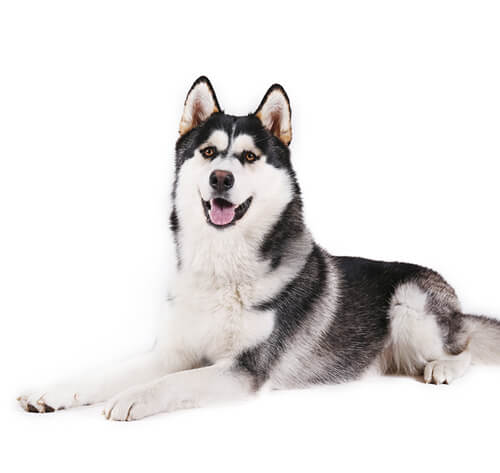
Alaskan Malamute
One of the oldest Arctic sled dogs, the Alaskan Malamute was first bred in Alaska to carry large loads over long distances. A majestic, dignified breed, the Malamute is highly intelligent and learns quickly, but he also can be strong-willed. Loyal, devoted and highly athletic, he is an affectionate family companion that enjoys outdoor activities. The Malamute needs daily exercise, and his thick, coarse coat requires daily brushing and occasional baths.
DID YOU KNOW? The Alaskan Malamute was named after a native Innuit tribe called the Mahlemuts, who settled in Alaska.
The need-to-know
- Dog suitable for experienced owners
- Some training required
- Enjoys vigorous walks
- Enjoys walking more than two hours a day
- Large dog
- Some drool
- Requires grooming every other day
- Non hypoallergenic breed
- Very vocal dog
- Guard dog. Barks and alerts
- May require training to live with other pets
- May require training to live with kids
Personality

The Malamute dog is an affectionate, friendly dog who is devoted to their family, though not the ideal breed for a first-time owner as they can be challenging to own. As well as their almost insatiable need to run, they love to dig and howl, are often escapologists, and can have a high prey-drive for small, furry creatures – be they squirrels, cats or even small dogs. For owners who understand them and can give them what they need to be healthy and happy however they make outstanding and head-turning companions.
History and Origins

Country of Origin: United States
The Malamute is one of the oldest and strongest of the northern sled dogs and was beloved of the Mahlemut people of Alaska for whom the breed took their name. It is unclear just how old the breed is but there is history that suggests that they have been working in Alaska for over 5000 years. Their size, strength and stamina meant that they were used to transport heavy loads - and a team of dogs would have been able to drag half a ton across challenging terrain for hundreds of miles. When they weren’t needed as sled dogs, they would be employed as livestock guards and used to help hunt moose or bear.
Nutrition and Feeding

Large breed dogs, as well as having large appetites, benefit from a different balance of nutrients including minerals and vitamins compared to smaller-breed dogs. The Alaskan Malamute dog breed is prone to bloating and stomach problems; smaller, more frequent meals can help minimise this risk.
Exercise

The Malamute needs at least two hours a day every day of active running exercise but would be happier with more. The rest of the time, they are quiet and generally content to relax - with the occasional howl… just for fun! They enjoy being outside but extremely high and secure fences are a must.
Other Information

Health and common issues
As with many breeds, Alaskan Malamute dogs can suffer from hereditary eye disorders, and hip dysplasia (a condition that can lead to mobility problems). Eye testing and hip scoring of dogs prior to breeding is therefore important.
Space requirements
A big house and well-fenced garden are important for an Alaskan Malamute - as is daily access to places to run. They are definitely not city dogs - and as they enjoy howling, they are best suited to living away from close neighbours.
Training alaskan malamutes
As this is a large dog, they need to learn all the usual basic manners that a training class will give them. The Alaskan Malamute never forgets that they are bred to pull sledges however - and so they need to learn to walk on a lead and harness for the occasions when they need to be under close control. Traditional dog walks are of little interest to a Malamute - they need to run and so training in sports like canicross can give them an appropriate outlet for their hard-wired behaviours. It goes without saying that they need extremely active owners who want a dog they can run with. While a good recall is extremely important and should be taught and practised, it shouldn’t be relied upon in the great outdoors when squirrels or just the need to run can make them deaf to anything else. If they are to live with other animals, early socialisation is vital and even then, care must be taken.
Best family dog breeds
Alaskan Malamutes can happily live with children as long as they are well socialised with them from an early age but as with any large dog, care should be taken. While many dogs are traditionally thought of as being good with children, all dogs and children need to be taught to get on with and respect each other, and be safe together. Even so, dogs and young children should never be left alone together and adults should supervise all interactions between them.
Did you know?
- Along with the lighter Siberian Huskies, Alaskan Malamutes were involved in The Serum Run of 1925 when 150 sled dogs transported diptheria antitoxin across Alaska coering 674 miles in just over 5 days, saving the small town of Nome and the surrounding communities from an epidemic.
- In World War 1, 450 Alaskan Malamutes were sent to France to deliver supplies to French army troops in mountain outposts.
- Previously they were used to deliver mail and transport supplies for the early settlers in Alaska.
- Alaskan Malamute’s were used in the Gold Rush to haul food and supplies over mountain passes.
- This breed was used to sniff for mines, carry weapons and act as search and rescue dogs in World War II.